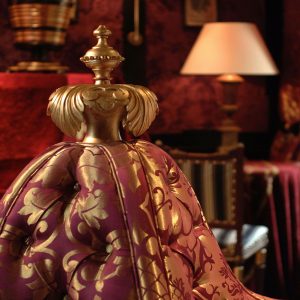 The fabrics used during Victorian era was cotton, linen, silk or wool. Many people have the impression that Victorian fashion was dark and gloomy giving great emphasis to black and dark brown. This is not true. The most important thing to be taken into account here is that Victorian era was a long one and fashion took many shifts within this period. Queen Victoria ascended the throne in 1837 and died in 1901 and women’s fashion underwent many changes throughout the era.
The fabrics used during Victorian era was cotton, linen, silk or wool. Many people have the impression that Victorian fashion was dark and gloomy giving great emphasis to black and dark brown. This is not true. The most important thing to be taken into account here is that Victorian era was a long one and fashion took many shifts within this period. Queen Victoria ascended the throne in 1837 and died in 1901 and women’s fashion underwent many changes throughout the era.
In fact, colour was generously used all through the Victorian era especially when it came to women’s dresses. Victorian women loved colour in their dress and by the middle of the century, brighter colours were created as compared to the previous ones.
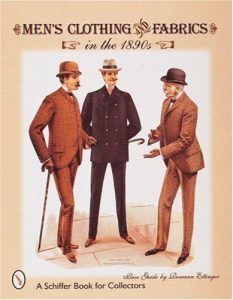 Men’s fabrics and colours
Men’s fabrics and colours
With time men’s clothes became soberer in colour. In 1850s darkish blues, light fawns and plaids for trousers were replaced by a general range of grey and black and the most favoured cloth was broadcloth. The colour trend was slightly relieved by a flash of colour added through a necktie and checked tweeds were used for country suits or checked for an Inverness caped coat. Silk was used occasionally and especially for waistcoats, linings and for some facings.
In 1890s, Victorian men used fabrics like linen, duck, pongee and seersucker in light fawns, beige and white during summer keeping white flannels and dark coloured wool blazers for sports. However, town or formal wear was dark grey or black in woollen cloth.
Women’s clothing 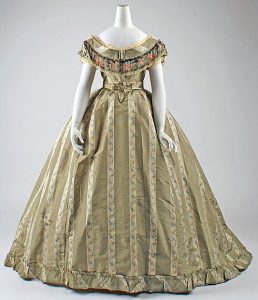
Women, on the contrary, preferred to use wide range of colours and fabrics when it came to making dresses. The fabric called taffeta was a beautifully crisp and light quality which was just perfect for bouffant styles and satin, backed with silk or cotton was firm enough to stand on its own. All through the Victorian era evening wear was generally light coloured even for the young ladies and fabric used was mostly cotton. A Victorian lady wearing all black was assumed to be mourning.
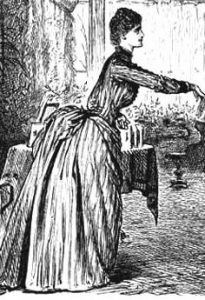 By 1860s silk, taffeta, moire, faille, silk, poplin and velvet were used for formal dresses and for more mature ladies. New colours were invented from many of the softer colours like electric blue, stringent magenta or vivid yellow. Liberal use of silks and the eastern influence shifted the fashion towards subtle colours, but in general fairly bold colour and pattern with broad stripes, passementerie braid with jet and guipure lace was used. Introduction of sheer fabrics paved way for softer style that eventually came in 1900s.
By 1860s silk, taffeta, moire, faille, silk, poplin and velvet were used for formal dresses and for more mature ladies. New colours were invented from many of the softer colours like electric blue, stringent magenta or vivid yellow. Liberal use of silks and the eastern influence shifted the fashion towards subtle colours, but in general fairly bold colour and pattern with broad stripes, passementerie braid with jet and guipure lace was used. Introduction of sheer fabrics paved way for softer style that eventually came in 1900s.
Use of fur 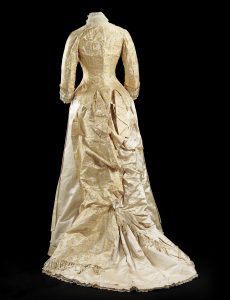
Right from well-to-do families, the desire to be well and fashionably dressed as well as be presentable increased among both, men and women by the half of the nineteenth century. Only the people who were very poor and depended on cast offs could not become the part of this trend. Normally, holidays and parties were opportunities for dressing up and exhibit impressions of prosperity and wealth as much as possible.
Upholstery fabric
Victorian curtains often used a lining of lightweight muslin or net with heavy curtains on the outside. They were suspended by brass poles with brass curtain hold backs with them. Victorians often chose darker colours for curtains and the quality as well as the taste of furnishings reflected the social status of the family.
 The curtains during that time were very heavy and expensive as well as were intended to last a whole lifetime. Since Victorians were very keen on privacy, the main purpose of the curtain was to keep out prying eyes. Second important function of the curtain was to protect furniture, rugs and paintings adoring the walls and floors of Victorian homes. Also, it was meant to keep the cold out and so the curtains were designed in specific style so that the folds of the cloth trapped the cold and acted as insulation.
The curtains during that time were very heavy and expensive as well as were intended to last a whole lifetime. Since Victorians were very keen on privacy, the main purpose of the curtain was to keep out prying eyes. Second important function of the curtain was to protect furniture, rugs and paintings adoring the walls and floors of Victorian homes. Also, it was meant to keep the cold out and so the curtains were designed in specific style so that the folds of the cloth trapped the cold and acted as insulation.
Victorian interior usually had dark colours like burgundy, plum, navy, ruby or emerald. For the heavy curtains, Victorians used fabrics from stunning velvet to subtle silk. The rich commonly boasted their interior with curtains made of velvet with floral prints on it. Along with curtain, other use of fabric was in rugs and for embroidery works as well which were displayed on household items as well as dresses.